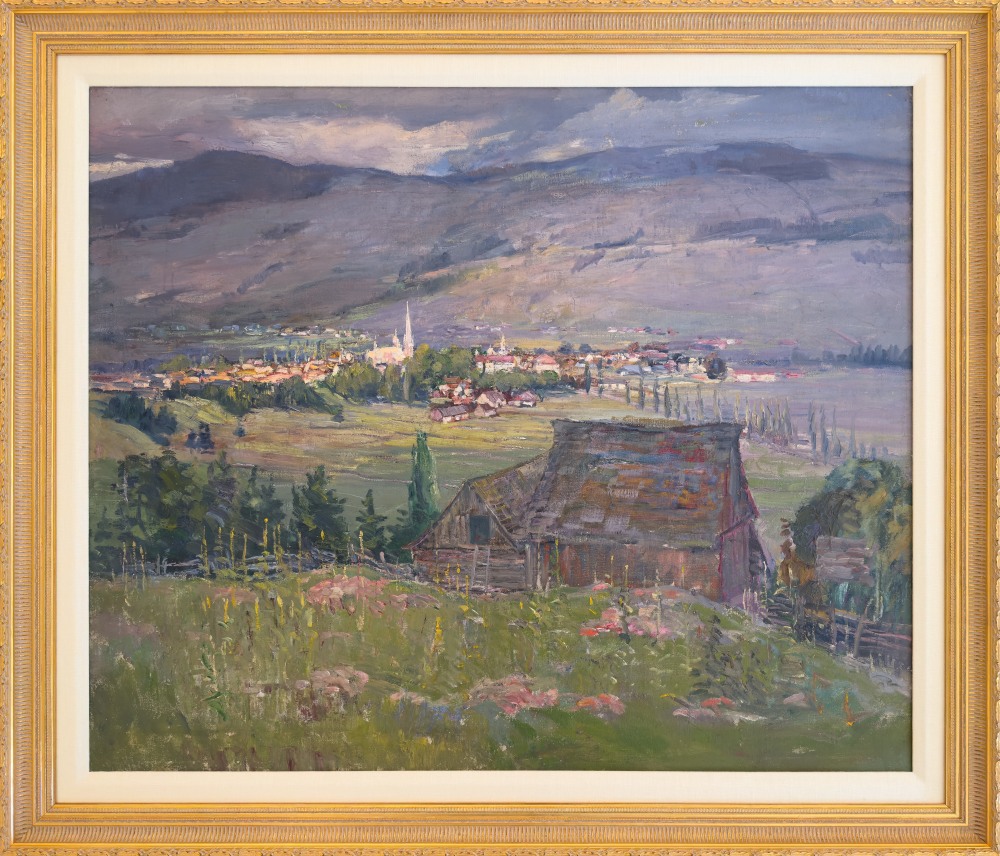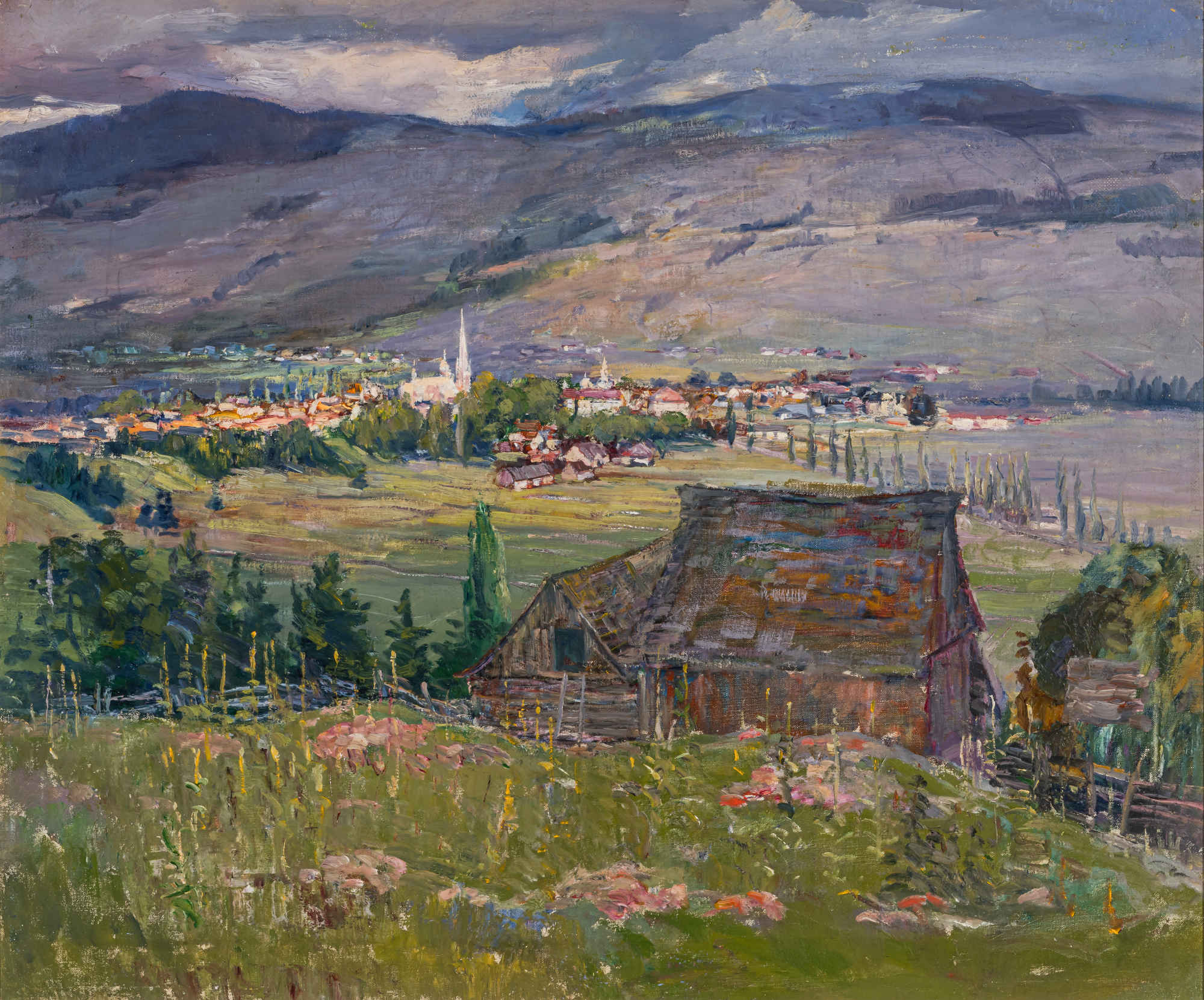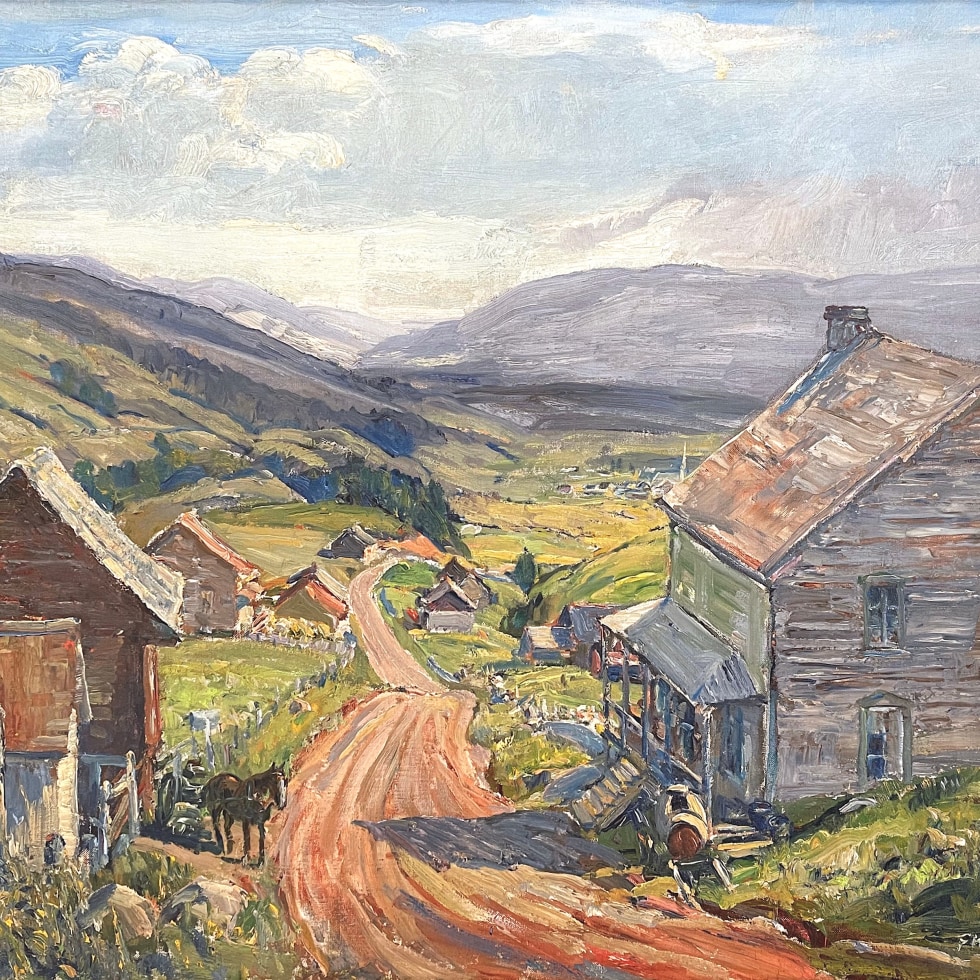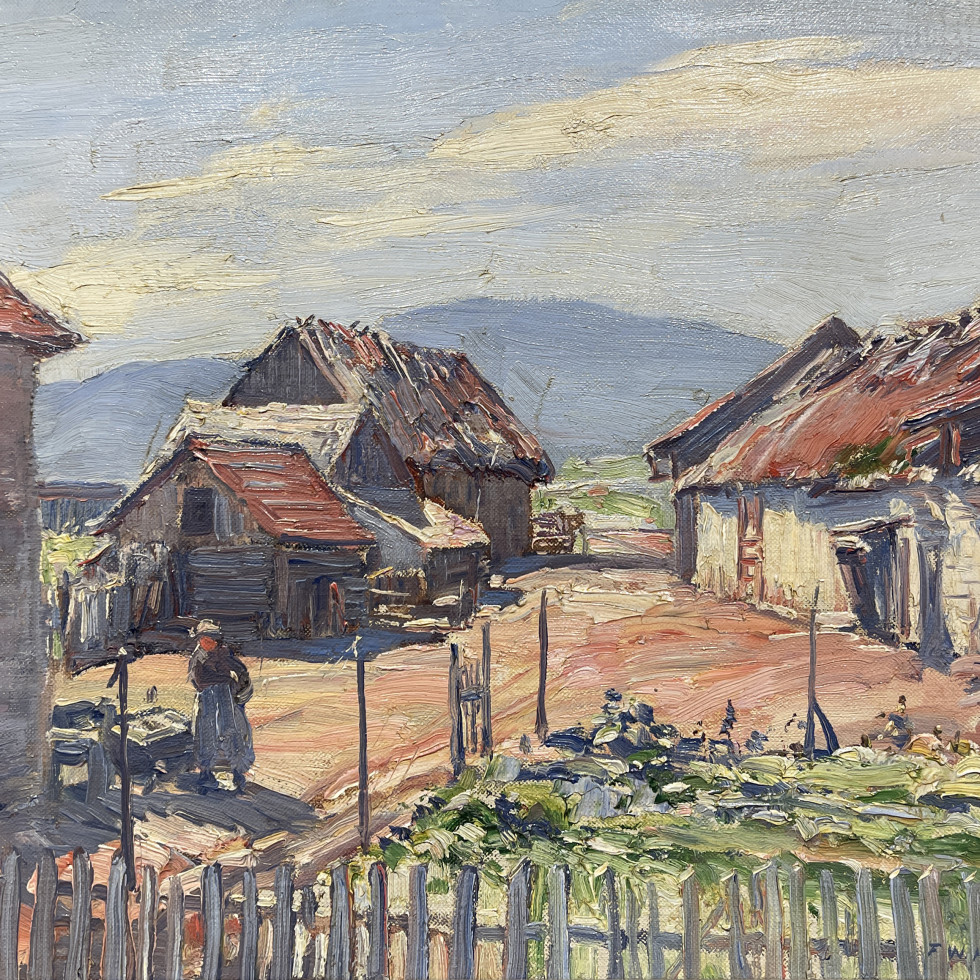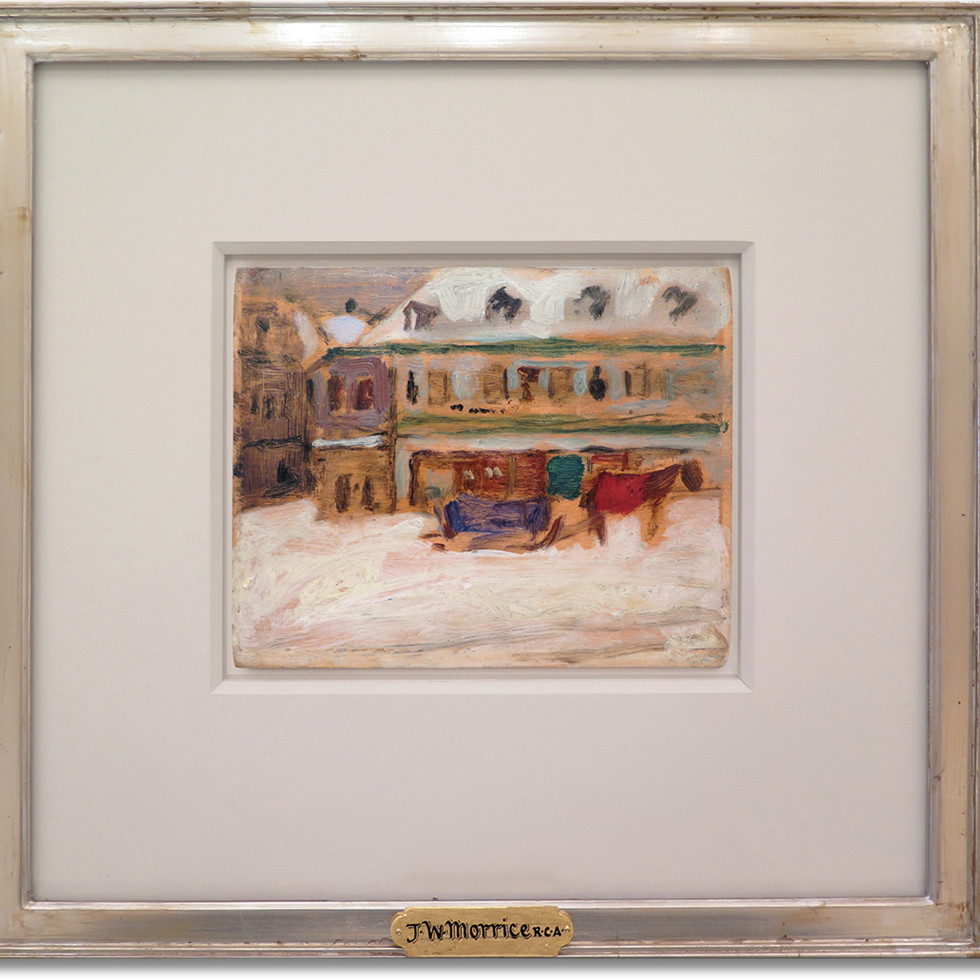Artwork for Sale
View toward Baie St Paul, 1930 (circa)
76.8 x 91.4 cm
Provenance
The Estate of F. W. Hutchison
Private collection, Hudson, Quebec and Niagara-on-the-Lake, Ontario (purchased from the Hutchison house directly)
By descent to the present private collection, Fort Erie
Literature
Stephanie A. Thomas, “Frederick William Hutchison (1871-1953)” (Master’s thesis, Concordia University, March 1982), 77.It is almost 100 years since the completion of this important painting by Fred Hutchison. The painting has maintained a freshness and vitality evidenced by the best of Fred Hutchison’s paintings of the Charlevoix region where he painted alongside his close friend Clarence Gagnon. Considering the aesthetic qualities of this painting, which was executed by an accomplished artist of the period, and its ability to testify to its time and place in the style of Canadian Impressionism, this Fred Hutchison painting represents a genuine value purchase.
In 1982, Walter Klinkhoff and our original family gallery, Walter Klinkhoff Gallery, assisted Concordia Masters student Stephanie Thomas in putting together a collection of Hutchison paintings to exhibit, illustrating her thesis on Hutchison. Fully 40 years later her Master’s thesis remains the foremost source of information about the artist and, in a large part for this text.
Although Fred Hutchison had offered his paintings at the important Montreal art gallery, Scott & Sons, for all intents and purposes it appears that it was when Hutchison retired and returned to the family home, Braeside, in Hudson, Quebec his father had originally built as a summer cottage, when Hutchison seems to have pursued greater interest in selling his paintings.
Montreal’s Stevens Art Gallery held Hutchison exhibitions in 1940 and 1946 while William Watson Art Gallery, Montreal’s legendary art dealing gallery, hosted an exhibition in 1949.
The coverage of Watson’s Hutchison exhibition in the Montreal Gazette of October 15, 1949 read ;
“Hutchison Exhibition at Watson Art Galleries: Lower St. Lawrence scenes predominate in collection of 70 paintings” [1]
Comprehensive in scope is the exhibition of Quebec scenes by F.W. Hutchison and a R.C.A. being held in the Watson art galleries, 1434 Sherbrooke St. W., the collection of 70 works, revealing how thoroughly he has captured and set down the atmosphere and spirit of the towns and villages on the lower St. Lawrence. Paint it with his characteristic breadth and confidence this offering is impressive and displays the marked talents of this Canadian artist.” [2]
Robert Pilot, who was a friend and sometime painting companion of Hutchison’s in the area of Baie Saint Paul wrote a Foreword in the catalogue, which accompanied the exhibition at Watson Art Gallery in 1949. He wrote:“He belongs to that fine group of Canadian painters: Morrice, Cullen, Gagnon and Jackson, who so beautifully interpreted the French Canadian countryside… The present exhibition, embracing as it does, the work of many years, cannot, but enhance the already high reputation of this fine and original artist.” [3]
That Pilot noted the exhibition was of paintings done over many years would reasonably imply that the artist still had a large number of paintings from the Charlevoix painting trips of the 1920s and ‘30, stored at Braeside in Hudson. One might legitimately speculate that Hutchison did not habitually take his paintings from his summer and early fall stays in Charlevoix to N.Y.C. but instead left them at Braeside where he and his wife Florence made their home in retirement. It is at Braeside where these paintings were originally purchased from Hutchison’s widow by the parents of today’s seller.
Stephanie Thomas wrote in her thesis “His explorations into light, atmosphere, seasonal and hourly changes and colour place his style within the category of generational impressionism. His preoccupation with interpreting Charlevoix county relates him to the Quebec approach to painting landscape.” [4]
Hutchison was a student of William Brymner at the Art Association of Montreal, then the Académie Julian and the École Colarossi for 2 years in Paris, followed by study in New York City with William Chase as the master. He taught at the College of the City of New York from 1905 for more than 3 decades. According to Stephanie Thomas, for more than 25 years Hutchison rented the same red brick cottage in Baie St. Paul belonging to Joseph Simard for part of the summer and early fall while on summer holidays from his teaching duties.
Art dealer William Watson, referring exclusively to paintings of scale, this canvas for instance, was painted entirely outdoors, he wrote that “Hutchison was one of the first of outdoor painters [...] Even his largest pictures have the freshness of sketches.” [5] Indeed, that freshness is remarkable in the painting we are offering. It is noteworthy that Randolph Hewton was also known to have painted on canvas in the outdoors.
Why he is not as well known as some of his peers is a question Stephanie attempts to answer. Her first suggestion is that because he spent the majority of the year during his mature career, teaching in New York and visited Hudson, Quebec and Charlevoix county for a few months in the summer he did not pursue to any serious extent exposure on either side of the border. Her second explanation relates to the “personality of the man himself. He was a quiet, gentle man, who loved to observe and contemplate life from a distance […] Had he been more aggressive and stayed in Montreal or New York all year round perhaps he would have left a more permanent mark on either city's art community. His problem in short was largely a matter of feasibility.” [6]
Hutchison's paintings are in the collections of The Art Gallery of Ontario, The National Gallery of Canada, Musée national des beaux arts du Québec, McGill University, The Beaverbrook Gallery, The Winnipeg Art Gallery, The National Academy of Design, NY.
______________________
Footnotes:
[1] Stephanie A. Thomas, “Frederick William Hutchison (1871-1953)” (Master’s thesis, Concordia University, March 1982), 17.
[2] Ibid.
[3] Ibid., 18 n. 89.
[4] Ibid., 50.
[5] Ibid., 36 n. 131.
[6] Ibid., 53.



